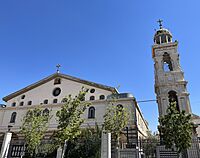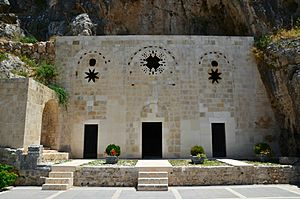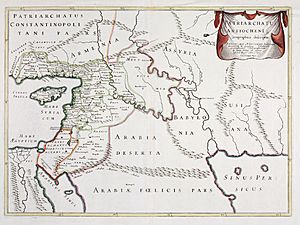Greek Orthodox Patriarchate of Antioch facts for kids
Quick facts for kids Greek Orthodox Patriarchate of Antioch and All the East بطريركيّة أنطاكية وسائر المشرق للروم الأرثوذكس |
|
|---|---|

|
|
| Type | Autocephaly |
| Classification | Christian |
| Orientation | Greek Orthodox (Antiochian) |
| Scripture | Septuagint, New Testament |
| Theology | Eastern Orthodox theology |
| Polity | Episcopal |
| Primate | John X (Yazigi), Patriarch of Antioch and All the East (since December 17, 2012) |
| Language | Koine Greek (historical), Aramaic (Classical Syriac) (historical), Arabic (official), Turkish (in Turkey), English, French, Portuguese, Spanish and other languages (extended) |
| Headquarters | Mariamite Cathedral, Damascus, Syria Traditionally: Church of Cassian, Antioch, Byzantine Empire Monastic residence: Balamand Monastery, Koura, Lebanon |
| Territory | Primary: Syria, Lebanon, part of Turkey, Iraq, Iran, Kuwait, Bahrain, Qatar, UAE, Oman, Yemen, Saudi Arabia (formerly also Cyprus, Georgia and parts of the Central Caucasus area) Extended: North America, Central America, South America, Western, Southern and Central Europe, Australia, New Zealand, Philippines |
| Founder | Apostles Peter and Paul |
| Independence | A.D. 519 |
| Recognition | Orthodox |
| Branched from | Church of Antioch |
| Separations | Georgian Orthodox Church – dates vary between 467 CE—491 CE and 1010 Melkite Catholic Patriarchate of Antioch – 1724 |
| Members | Approx. 4.3 million (2012) |
The Greek Orthodox Patriarchate of Antioch is also known as the Antiochian Orthodox Church. It is a major Christian church that started in the ancient city of Antioch. This church is part of the larger group of Eastern Orthodox Christian churches.
It believes it continues the Christian community first started in Antioch by the Apostles Peter and Paul. Today, it is one of the biggest Christian groups in the Middle East. Many of its followers, called Antiochian Christians, live in the Levant region, which includes parts of Turkey, Syria, and Lebanon. Many also live in other parts of the world. About 4.3 million people are part of this church.
Contents
About the Antiochian Orthodox Church
The main office of the Patriarchate used to be in Antioch, which is now in Turkey. In the 1300s, it moved to Damascus, the capital of Syria. The church's traditional area includes Syria, Lebanon, Iraq, Kuwait, and other Arab countries in the Persian Gulf. It also covers parts of Turkey.
The church in Cyprus used to be part of the Antiochian Church. But it became independent in 431 AD. Both the Antiochian and Cypriot Orthodox Churches are members of the Middle East Council of Churches.
The church has branches in other parts of the world. Its branch in North America is self-governing, but the main church in Antioch still chooses its head bishop. The branch in Australia and Oceania covers a very large area.
The leader of the Antiochian Orthodox Church is called the Patriarch. The current Patriarch is John X (Yazigi). He was chosen on December 17, 2012. He became the leader after Ignatius IV passed away. The main church building for the Patriarch in Damascus is the Mariamite Cathedral of Damascus.
The Greek Orthodox Church of Antioch is one of several churches that claim to be the original church of Antioch. Other churches, like the Syriac Orthodox Church and the Maronite Church, also make this claim.
History and Traditions
Early Christian Roots

The city of Antioch was very important in early Christianity. The Bible says that followers of Jesus were first called "Christians" in Antioch.
The Apostles Peter and Paul are seen as the founders of the Antiochian Church. Peter was its first bishop. After Peter left Antioch, Evodios and Ignatius led the church. Both Evodios and Ignatius died for their faith during Roman times.
The church's traditions were shaped by a mix of Greek and Jewish cultures. Many early Christians in Antioch were Jewish people who spoke Greek. Over time, many non-Jewish Greeks also joined the church.
Some historians believe that many Greek-speaking Jewish communities and Greek settlers in Southern Turkey and Syria/Lebanon became Christians. This led to the "Melkite" (or "Imperial") Greek churches in Western Asia and North Africa.
The Bible also shows that there were some differences between Jewish Christians who spoke Aramaic (from Jerusalem) and those who spoke Greek (from Antioch).
A New Way of Thinking
These cultural differences were eventually overcome by a new idea from Paul. Paul, who was a Greek-speaking Jew, taught that in Christ, there is no difference between people based on their background. This idea helped unite different groups of people in the church.
Paul's work was helped by new groups of Greek-speaking people coming to the area. These included Jewish people from Cyprus and Libya, and Roman settlers from Italy. Many of them already spoke Greek.
This idea is summed up in the Bible verse from Galatians 3:28: "There is neither Jew nor Greek: there is neither slave nor free: there is neither male nor female. For you are all one in Christ Jesus."
"Eastern Romans" and "Melkites"
The Antiochian Christian traditions are a special mix of Roman, Greek, and Jewish influences. Antioch was a very important place for the early church.
Members of the church in Southern Turkey, Syria, and Lebanon still call themselves Rūm. This Arabic word means "Eastern Romans" or "Asian Greeks." It shows their connection to the Roman and Byzantine empires. They also call themselves "Melkites," which means "supporters of the emperor." This name shows their loyalty to the old imperial rule. Today, the term "Melkite" is more often used by followers of the Greek Catholic Church of Antioch.
After the fall of the Turkish Ottoman Empire and the Russian Empire, some members of the Greek Orthodox Church of Antioch supported new ideas like secularism and Arab Nationalism. They hoped these ideas would help modernize countries like Syria and Lebanon.
Church Leadership and Organization
The Patriarch's Role
The Patriarch is the main leader of the church. He is chosen by a group of bishops called the Holy Synod. The Patriarch leads the Holy Synod and makes sure its decisions are carried out. He is also the bishop for the area of Antioch and Damascus.
The current Patriarch, John X (Yazigi), was chosen on December 17, 2012.
Archdioceses and Bishops
The church is divided into 22 main areas called archdioceses. Each archdiocese is led by a bishop called a metropolitan.
Archdioceses in Western Asia
- Archdiocese of Antioch and Damascus: This is the main area led by the Patriarch.
- Archdiocese of Akkar and Dependencies
- Archdiocese of Aleppo, Alexandretta and their Dependencies
- Archdiocese of Beirut and Exarchate of Phœnicia
- Archdiocese of Baghdad, Kuwait and Dependencies
- Archdiocese of Bosra, Hauran and Jabal al-Arab
- Archdiocese of Byblos and Batroun
- Archdiocese of Hama and Exarchate of North Syria
- Archdiocese of Homs
- Archdiocese of Latakia and Exarchate of Theodorias
- Archdiocese of Tripoli and Koura
- Archdiocese of Tyre and Sidon
- Archdiocese of Zahleh and Baalbek
Archdioceses in Asia and Oceania
- Archdiocese of Australia, New Zealand and the Philippines
Archdioceses in Europe
- Archdiocese of the British Isles and Ireland
- Archdiocese of France, Western and Southern Europe
- Archdiocese of Germany and Central Europe
Archdioceses in the Americas
- Archdiocese of North America
- Diocese of Oakland, Charleston, and the Mid-Atlantic
- Diocese of Eagle River and the Northwest
- Diocese of Los Angeles and the West
- Diocese of New York and Washington, D.C.
- Diocese of Miami and the Southeast
- Diocese of Ottawa, Eastern Canada and Upstate New York
- Diocese of Toledo and the Mid-West
- Diocese of Wichita and Mid-America
- Diocese of Worcester and New England
- Archdiocese of Buenos Aires and All Argentina
- Archdiocese of Mexico, Venezuela, Central America and the Caribbean
- Archdiocese of Santiago and All Chile
- Archdiocese of São Paulo and All Brazil
Other Bishops
The church also has bishops for special roles or smaller areas. These include:
- Diocese of Shahba
- Diocese of Darayya
- Diocese of Saidnaya
- Diocese of Banias
- Diocese of Arthoussa
- Diocese of Zabadani
- Diocese of Palmyra
- Diocese of Edessa
- Diocese of the Emirates
- Diocese of Erzurum
- Diocese of Resafa
- Diocese of Apamea
- Diocese of Diyarbakır
Churches That Came From Antioch
Many other Christian churches have historical ties to the Church of Antioch. Some of these churches became independent over time.
- Orthodox Churches:
- Church of Constantinople: Became independent in 381 AD.
- Church of Cyprus: Became independent from Antioch in 431 AD.
- Church of Jerusalem: Became a Patriarchate in 451 AD.
- Church of Georgia: Believed to have become independent from Antioch between 467 and 491 AD.
- Church of Imereti and Abkhazia: Became independent in the 1470s, but later rejoined the Georgian Orthodox Church.
- Oriental Orthodox Churches:
- Syriac Orthodox Patriarchate of Antioch and all the East: Formed in 518 AD.
- Catholic Churches (in communion with Rome):
- Maronite Patriarchate of Antioch and all the East: Started in the 5th century.
- Melkite Catholic Patriarchate of Antioch: Joined the Catholic Church in 1724.
- Syriac Catholic Patriarchate of Antioch: Joined the Catholic Church in 1662.
More to Explore
- Eastern Orthodoxy in Syria
- Antiochian Greeks
- Antiochian Orthodox Archdiocese of North America
- Early Christianity
- Eastern Orthodox Church
- Greek Orthodox Church
- Hellenistic Judaism
- List of Greek Orthodox Patriarchs of Antioch
- List of Orthodox Churches
- List of Patriarchs of Antioch
- Eastern Orthodoxy in Lebanon
- Eastern Orthodoxy in Turkey
- Pentarchy
- Saint John of Damascus
- Saint Joseph of Damascus
- Saint Raphael of Brooklyn
- List of Greek Orthodox Antiochian Churches in Europe
See also
 In Spanish: Iglesia ortodoxa de Antioquía para niños
In Spanish: Iglesia ortodoxa de Antioquía para niños



